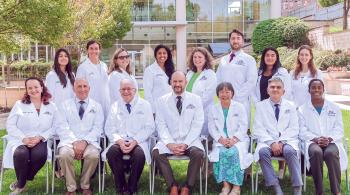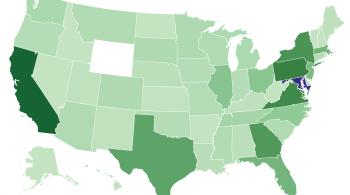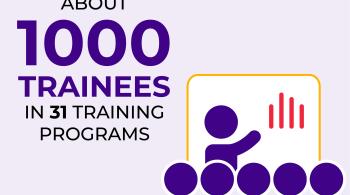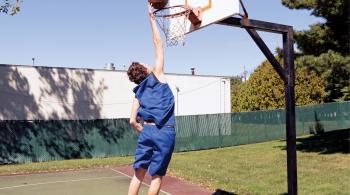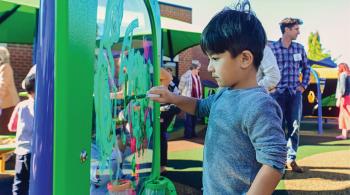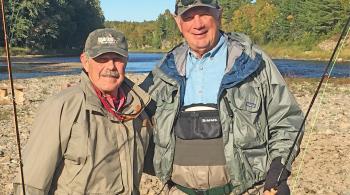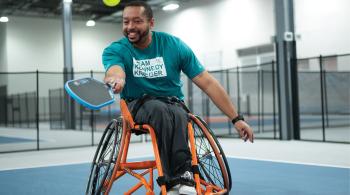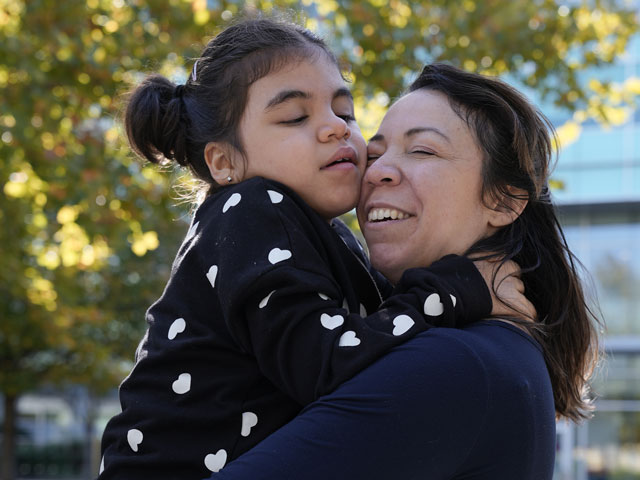
By Laura Thornton
The first thing you notice about Violet is her smile. “It lights up the room,” says Dr. Ryan Gill, her pediatric neurologist at Kennedy Krieger Institute.
“Violet loves balloons, bubbles, balls, blowing raspberries and Cabbage Patch Kids dolls,” her mom, Inez, adds. “She laughs when she sees a new show that she likes. She has this condition, but she still enjoys her life, and she’s very content.”
Violet, 6, has TBCK syndrome, also known as TBCK-related encephalopathy. She’s the only Marylander known to have it. Caused by a mutation of the TBCK gene, the syndrome was first described in 2015. It can cause seizures, low muscle tone, respiratory and gastrointestinal issues, and developmental delays and regression. Fewer than 50 people in the world have been diagnosed with the condition, which is more common in individuals of Caribbean descent than in the general population, explains Dr. Mahim Jain, a bone health specialist at Kennedy Krieger.
Violet wasn’t diagnosed until she was 2. Until then, her parents kept searching for answers as to why their little girl struggled to meet her milestones. In 2018, they brought her to Kennedy Krieger for whole exome testing, one of the most extensive genetic tests available. The biomarker for TBCK syndrome had recently been found, and testing revealed that Violet had the condition.
A New Journey
That was just the start of a new journey for Violet’s family. “It’s hard when you’re first learning about something your child has,” Inez says. Seizures, she was told, would begin soon, and could be severe. “When she had her first seizure, that was the scariest thing.”
But at Kennedy Krieger, Violet’s parents found a care team for Violet with a wide breadth of expertise and an equal amount of care and concern for Violet and her family. “Every person Violet has come across at Kennedy Krieger is so genuine—it’s like we’re family. They’re giving her the stepping stones she needs to experience and enjoy life.”
Violet sees Dr. Gill a few times a year. She monitors Violet’s seizures, and tweaks her antiseizure medications as needed. “Dr. Gill is amazing,” Inez says. “She lets me pick her brain all the time.” That’s important—since TBCK syndrome is such a newly described condition, there’s not a lot of information available on it yet. Anything that Inez has a question about, Dr. Gill looks into. Any concern Inez has, Dr. Gill takes very seriously.
Violet also meets once a year with Dr. Jain, and about every six months with Dorian Butler, a nurse practitioner for the Institute’s Bone Center. “Because Violet is not very mobile and has a history of osteoporosis, it’s important to monitor her bone health and ensure she’s doing things to keep her bones strong, even though she doesn’t walk,” Butler explains.
“I’m so happy she’s coming to our clinic now, when she’s young, so we can establish a baseline for her,” she adds. “We want to monitor her bone health as she grows and minimize her risk for fractures.”
Positive Energy
To keep her bones strong, Violet uses a stander for about half an hour a day at school. It’s a device that allows her to stand—putting weight on her leg and hip bones—while she engages in classroom and learning activities. She also does physical therapy, both at school and at Kennedy Krieger, to stay strong and maintain the mobility that she has.
Violet also benefits from occupational therapy at Kennedy Krieger. “We work a lot on developmental fine motor skills,” such as picking up an object with one hand and putting it in the other hand, explains Rachel Cassidy, Violet’s occupational therapist. Cassidy is also helping Violet learn to feed herself by picking up a spoon and putting it in her mouth. “My goal with Violet is to make functional gains,” Cassidy says. “I want Violet to be as independent as possible.”
Many of Violet’s sessions with Cassidy take place in the Institute’s sensory gym, with swings, floor mats, bubble tubes and other equipment designed to activate the senses. Violet loves the room and always brings her smile to therapy. “When I meet her in the lobby to bring her back to the gym, she’s always very excited,” Cassidy says. “She has such a positive energy.”
Violet recently did outpatient oral motor therapy with speech-language pathologist Claire Warren of the Institute’s Speech and Language Department to determine the types of foods she can chew, given that her oral strength and oral motor skills aren’t very strong.
“We determined that Violet could continue with pureed foods and liquids, and that she could tolerate up to about 10 bites of more solid food on each side of her mouth per meal,” Warren says. During feeding sessions, Warren got a chance to see Violet’s spunky personality. “Working on chewing became an activity that Inez and Violet enjoyed doing together, with Inez finding new foods that Violet would like.”
I’m so glad to have the team at Kennedy Krieger. I don’t know what I’d do without them.” – Inez
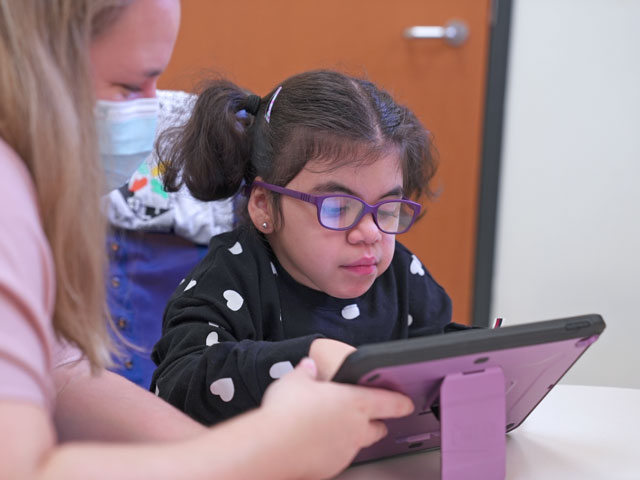
An Active Communicator
While Violet is nonspeaking, she communicates through facial expressions, pointing and reaching. An evaluation last year by speech-language pathologist Mary Boyle indicated that Violet could use a communication system—pointing or looking at objects or pictures on cards or an iPad-like screen—to express herself. “She’s an active communicator. She engages with people, and will look at the person or thing she wants,” Boyle says.
“We have to watch her eyes, because her eyes are telling us what she is trying to communicate,” she adds. “If we’re waiting for a large motor or vocal response, we may miss so many interaction opportunities. And by missing them, they’re not reinforced, and without reinforcement, they get diminished.”
That reinforcement is also an opportunity for personal connection. “She’s asked for something and has been heard. We are attending to her in the ways in which she can communicate. Interaction builds communication,” Boyle explains.
Recently, Violet and Inez met with Alexis Tutor, a speech-language pathologist for Kennedy Krieger’s Assistive Technology Clinic, to start to put together a communication system for Violet that she can try out at home with her family. “Our biggest goal for Violet is to help her be as independent and communicating as possible,” Tutor says.
“While Violet doesn’t talk, I want her voice to still be heard,” Inez says.
Shortly after Violet’s diagnosis, Inez connected with the TBCK Foundation, which formed in 2018 to raise funds for research on TBCK syndrome, and to bring together families from around the world affected by the disorder. The foundation recently held its second in-person conference.
Being part of the group has helped Inez not feel so alone, as the parent of a child with a very rare disorder. And, as the foundation has empowered her, she wants to help other families of children with TBCK syndrome. She now serves on the foundation’s Parent Leadership Advisory Board, and is spreading the word about the importance of research and ongoing therapies—to give people with TBCK syndrome a voice in the world.
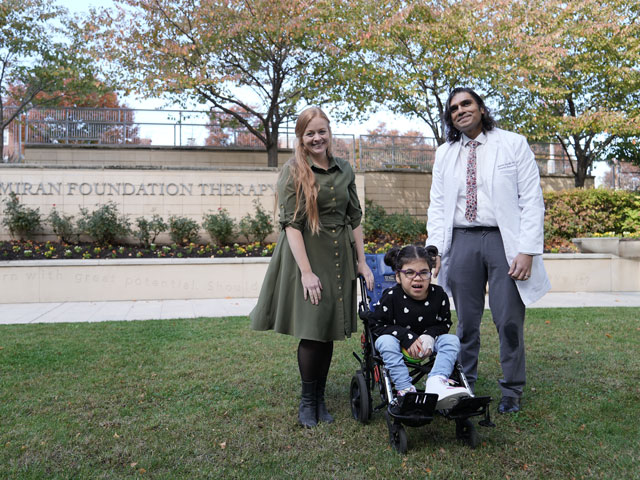
Dr. Ryan Gill, Violet and Dr. Mahim Jain
Inez is grateful that Kennedy Krieger is only an hour’s drive away from home. “I’m so glad to have the team at Kennedy Krieger. I don’t know what I’d do without them, or the TBCK Foundation. It was hard at first, learning about Violet’s diagnosis, but to see her thriving through it is amazing. Every little milestone, everything she does just makes me happy.”

